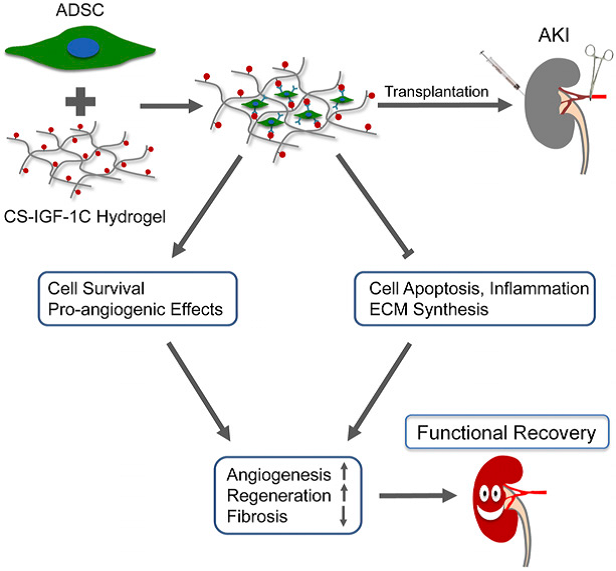JASN:南开大学李宗金、赵强教授等发表急性肾损伤细胞治疗研究
2016年3月17日,国际肾脏病学领域著名期刊《Journal of the American Society of Nephrology》在线发表南开大学“心血管组织工程”教育部创新团队李宗金、赵强教授和与天津医科大学第二医院徐勇教授合作在急性缺血性肾脏损伤细胞治疗方面取得重要进展。论文题为“胰岛素样生长因子1的C结构域修饰的水凝胶提高了急性肾脏缺血细胞治疗的疗效”(IGF-1 C domain-modified hydrogel enhances cell therapy for AKI)。博士研究生冯国威为论文第一作者,南开大学“心血管组织工程”创新团队李宗金、赵强教授和天津医科大学徐勇教授为共同通讯作者。
急性肾损伤(Acute Kidney Injury, AKI)是临床上常见的危重症,我国成人住院病人的患病率可达11.6%,每年我国发生的AKI病例数高达数百万例。AKI缺乏特异性的治疗手段,住院AKI患者的死亡率高达8.8%。
干细胞治疗AKI是近年来本领域的重大进展之一,但由于移植体内的细胞受到局部缺血缺氧环境影响,早期发生凋亡。因此,利用生物活性材料构建仿生细胞微环境改善干细胞存活并增强其特定功能成为细胞治疗领域研究热点。
南开大学“心血管组织工程”教育部创新团队设计制备了胰岛素样生长因子-1(IGF-1)的功能性多肽片段(IGF-1C)并将其固定到壳聚糖水凝胶,利用这种活性材料负载干细胞共同移植,期望改善局部微环境,增强移植细胞的存活及旁分泌功能,促进肾脏再生。
研究发现IGF-1C修饰的水凝胶在体外具有良好的生物相容性,能够促进脂肪干细胞(ADSCs)增殖并增强其抗凋亡能力;体内研究中,修饰的水凝胶增强移植ADSCs存活、增殖和迁移能力,加速肾脏组织学和功能学修复。这些治疗效应可能与促进肾小管上皮细胞增殖、减少凋亡、减轻炎症反应、刺激血管新生以及缓解慢性纤维化等旁分泌机制有关。
该杂志还同期刊发了编者评述“修饰的水凝胶提高了急性肾脏缺血细胞治疗的疗效:应对转化医学的挑战”(Modified hydrogels to enhance cellular therapy for AKI: a translational challenge)。

图为活性水凝胶CS-IGF-1C促进脂肪来源干细胞(ADSCs)肾脏保护作用的机制。水凝胶提高了ADSCs的存活率,增强了于细胞旁分泌、抗炎和抑制细胞外基质合成的作用,促进了血管新生和组织再生,显著抑制纤维化并改善了急性肾脏损伤(AKI)后肾脏的功能。
原文链接:
IGF-1 C Domain–Modified Hydrogel Enhances Cell Therapy for AKI
原文摘要:
Low cell retention and engraftment after transplantation limit the successful application of stem cell therapy for AKI. Engineered microenvironments consisting of a hydrogel matrix and growth factors have been increasingly successful in controlling stem cell fate by mimicking native stem cell niche components. Here, we synthesized a bioactive hydrogel by immobilizing the C domain peptide of IGF-1 (IGF-1C) on chitosan, and we hypothesized that this hydrogel could provide a favorable niche for adipose-derived mesenchymal stem cells (ADSCs) and thereby enhance cell survival in an AKI model. In vitrostudies demonstrated that compared with no hydrogel or chitosan hydrogel only, the chitosan–IGF-1C hydrogel increased cell viability through paracrine effects. In vivo, cotransplantation of the chitosan–IGF-1C hydrogel and ADSCs in ischemic kidneys ameliorated renal function, likely by the observed promotion of stem cell survival and angiogenesis, as visualized by bioluminescence imaging and attenuation of fibrosis. In conclusion, IGF-1C immobilized on a chitosan hydrogel provides an artificial microenvironment for ADSCs and may be a promising therapeutic approach for AKI.
作者:李宗金、赵强

